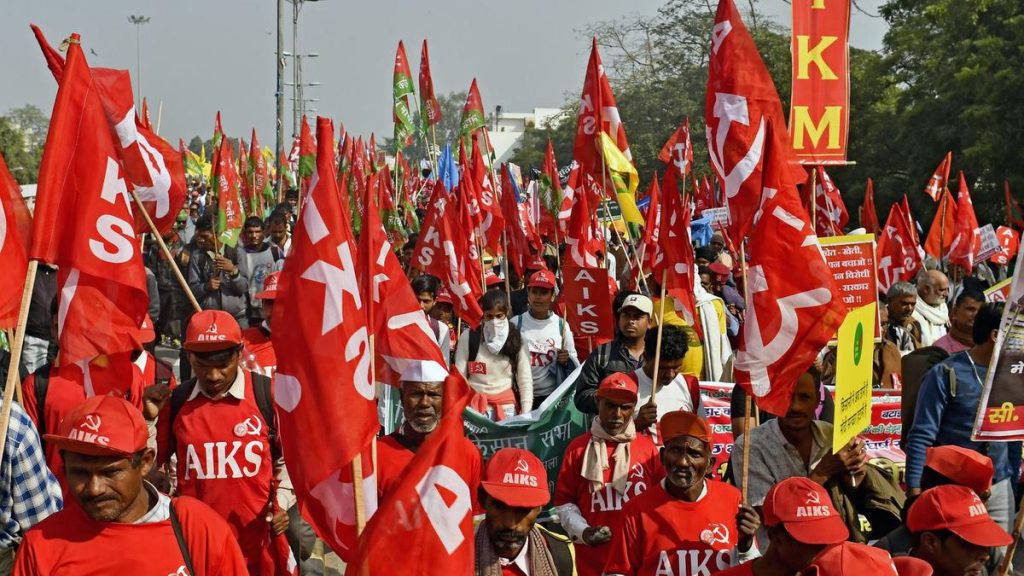State assembly election results in five Indian states are being announced today. However, exit polls earlier indicated a worrying outcome for Prime Minister Narendra Modi. His Bharatiya Janata Party was predicted to lose in Rajasthan, and to fall short of a majority in Madhya Pradesh, which it has held for 15 years.
Rajasthan has swung against its governing party in every election in the past 20 years, but this time the anti-incumbent vote was different. Farmers in the state were restive and, like those in Madhya Pradesh, keen to make their voice heard via the ballot box.
What they planned to say has been on Indian television screens and newspaper front pages for weeks. It can hardly have been pleasant for Mr Modi to hear.
India’s farmers are in acute distress and votes were cast against a backdrop of protest marches. On November 30, two days after Madhya Pradesh voted, and a week before the Rajasthan election, thousands of farmers marched on parliament in New Delhi. They demanded a special legislative session on the deepening crisis in agriculture. And they pleaded — desperately, angrily — for action. Crop prices should be raised enough to provide a living, they said. And the government should help with soaring fertiliser and diesel costs, as well as debt-waivers in times of drought.
It was the fourth such protest this year and drew farmers from across the country. Significantly, it was organised by All India Kisan Sangharsh Coordination Committee, a body formed less than two years ago that claims to be the first nationwide representative of more than 200 farm and agricultural workers’ associations. Clearly, India’s farmers are going from quiet despair to white-hot fury.
The intensity of that discontent can be gleaned from events in the Mandsaur district of Madhya Pradesh. In June last year, a leaderless farmers’ protest against falling crop prices turned violent. Some shops and vehicles were set ablaze. The police fired on protesters, killing a total of six farmers. The local community responded with defiance. Dilip Patidar, a Mandsaur farmer, told an Indian newspaper shortly before the latest elections: “We have run out of patience. This time we will do a patiya ullar (vote against the government).” Mr Modi might well worry that this unforgiving mood will find resonance among India’s 263 million farmers, a significant voting bloc.
Mandsaur is part of a politically important, rural region in Madhya Pradesh. Discontent there could be a harbinger of what is to come in India’s general election, which is due to take place by May 2019. Accordingly, the latest batch of state assembly elections have been viewed as a mini-referendum on the Modi government.
But Mandsaur could be seen as a metaphor too. When protesting farmers die at the hands of the state security forces, it suggests, at the very least, a troubling disconnect between ordinary people and their own government. What has gone so badly wrong?
In fairness, the Modi government has merely exacerbated an existing crisis, not caused it. In 70 years as an independent nation, India has achieved great success in being able to feed itself, build up surpluses and become one of the world’s leading exporters of agricultural products. But that has not meant better lives and prospects for most farmers.
Data released in 2016 by the Ministry of Agriculture & Farmers’ Welfare said farmers in 17 Indian states earned less than 20,000 rupees (Dh1,013) a year, on average. Government loans and crop insurance policies have mostly helped better-educated farmers with bigger landholdings. Small and marginal ones are forced to turn to rapacious moneylenders when they need cash. As an indicator of the scale of India’s agararian crisis, more than 300,000 farmers have taken their own lives since 1995.
More than half of India’s population is employed in agriculture, but the sector accounts for only around 17 per cent of the country’s GDP. Agricultural productivity has been falling in the past two decades, but farming costs have risen. Meanwhile, arbitrary government curbs on farm exports have stymied hopes of a secure income. There are few “more-crop-per-drop” irrigation systems and hardly any agricultural extension programmes, in which new techniques are taught to farmers.
The outlook for farmers was grim, even when Mr Modi came to power in 2014 promising the doubling of agricultural incomes. In an attempt to contain food inflation, he lowered crop procurement prices, instituted well-meaning government buy-up schemes that haven’t really worked, and capped it all with the 2016 scrapping of high-value currency notes. Demonetisation paralysed farm commodities trading and prices sank even lower.
As India prepared for independence from Britain in 1947, Jawaharlal Nehru, the man who would become the nation’s first prime minister, summed up his poor, populous country’s priorities. “Everything else can wait but not agriculture,” he said.
For farmers, though, the wait has been far too long.


